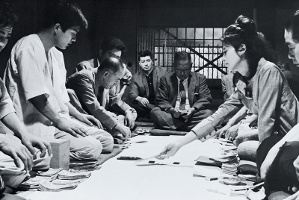by Scott Adlerberg
Funny, I've seen a couple of big films recently that I found slightly underwhelming. The Revenant was one and Quentin Tarantino's The Hateful Eight was another. Not that I disliked either, but neither lived up to the expectations I had for them going in. On the other hand, it's always a joy when you watch a film you never even heard of before, and it turns out to be something that sticks with you. That's what happened with the Japanese film Pale Flower, which I saw about a month ago.
A friend called me
up on a Saturday night asking whether I knew the film. Had I seen it? No
and no, but since he was so excited about it, I became stoked to see it also.
Pale Flower, a 1964 crime film directed
by Masahiro Shinoda. Part of the
Criterion Collection (always a good sign) and available for instant viewing
through Hulu. I didn't have Hulu, but after my wife and son fell asleep
that night, around eleven o'clock, I said screw it, signed up for Hulu, and
searched out Pale Flower.
For anyone who likes Japanese movies, for anyone who
likes crime movies, for anyone who likes noir - I say, "See this
movie." It's a beauty, filmed in crystalline, widescreen black and white.
The story's pretty simple: A middle-aged yakuza named Muraki gets out of jail
after serving a term of a few years and becomes involved with a seductive
young woman (Saeko) who he discovers is a gambling addict. While he's an
old-school kind of gangster, stoical to the core, she's an impulsive thrill seeker. She's
well-to-do and seems to be slumming it in the underworld. He falls for
her, and it seems that the life force she possesses will be something that
helps him rejuvenate himself and re-adapt to the outside world. It doesn't
quite work out that way; her penchant for taking chances and seeking out danger
really is a full-throttled self-destructiveness, and Muraki realizes that if he
stays with her, she will destroy them both. Still, can he go back to the
empty life he had before he met her?
This film has an odd mood, at once swoony and
detached. Most of the film takes place at night, on rainy streets or in gambling dens. There's a strange car race Saeko gets them into on an empty dark highway, her only purpose, it seems, to experience yet another thrill. Doom hangs over every frame of this movie, in true noir fashion, and besides being gorgeously shot, the film has a striking score, composed by the great Toru Takemitsu. There is a gangster sub plot to go along with
the twisted romance, and Muraki finds himself in the middle of
everything, with life-defining choices to make.
All this in about 90 minutes (How long was The Revenant? 2 hours and 36
minutes. How long was The Hateful Eight,
roadshow edition? 3 hours and 7
minutes), a 90 minutes I would gladly sit through again tomorrow.
Bleak
yet somewhat dreamlike, Pale Flower is a film that has a modern feel even
though it’s over 50 years old. It doesn’t
strive hard for weight; it achieves its cool existential tone through economy, pacing, and atmosphere. There is a mixture of emotion and reserve in the performances. And obviously, if I’m talking about it now, a
month after seeing it, I'd call it a film that lingers in your mind. Anyway, I’m glad my friend turned me on to it
with his phone call on a Saturday night and that I then had one of those great
movie times that results when something you didn’t know about turns into
something you recommend to others.



No comments:
Post a Comment